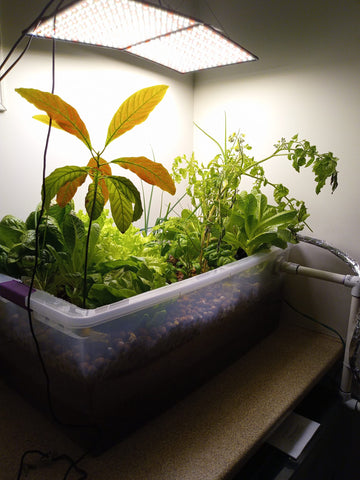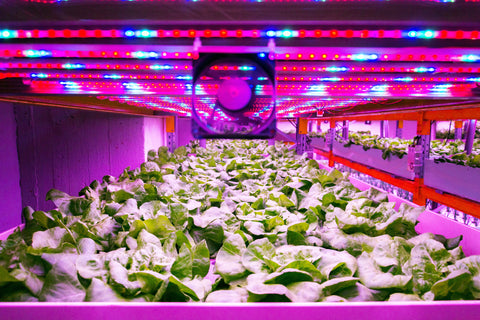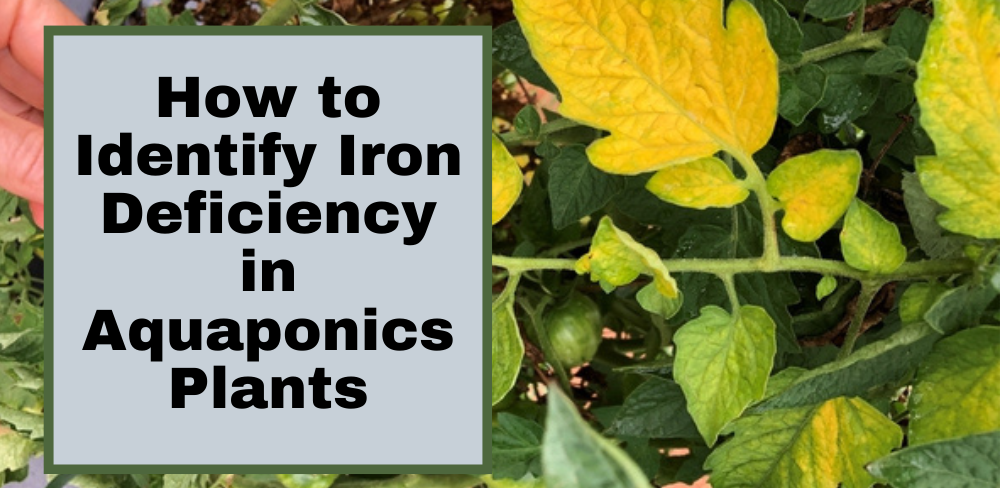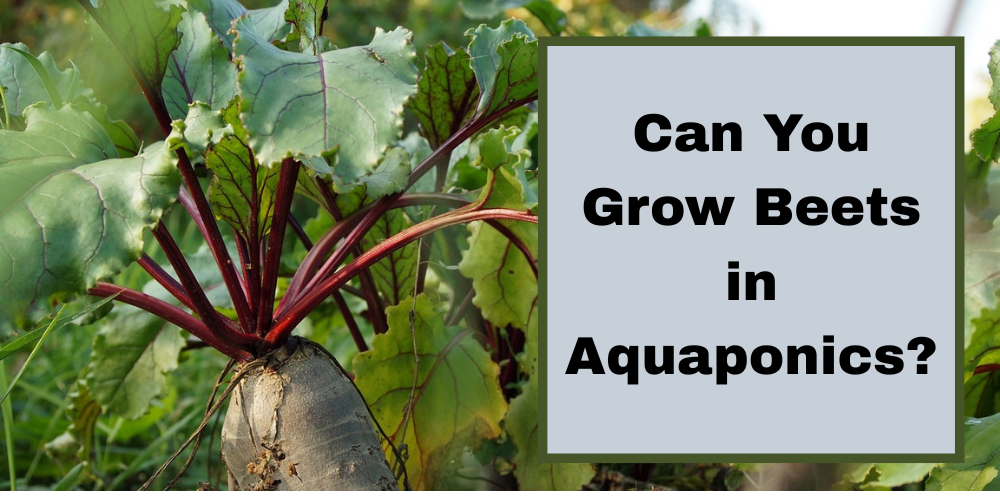While the dynamics of nutrient cycling are well-established in aquaponics, the role of light in this ecosystem is equally crucial. Light serves as the energy source for photosynthesis that drive plant growth and influence the productivity of the entire system.
However, the question arises: do aquaponics greenhouses need artificial grow lights, or can they rely solely on natural light? This article aims to delve into this question and explore the interplay between natural and artificial lighting in aquaponics greenhouses to determine their necessity and impact on the system's performance. By understanding the importance of light in plant growth and considering various factors that influence lighting requirements, we can gain insights into optimizing light conditions for sustainable and efficient aquaponics operations.

The Role of Light in Plant Growth
Light serves as the primary energy source for photosynthesis, the process by which plants convert light energy, carbon dioxide, and water into glucose (a form of sugar) and oxygen. This process occurs within specialized cellular structures called chloroplasts, which contain chlorophyll, the pigment responsible for capturing light energy.
In photosynthesis, light energy is used to split water molecules into oxygen and hydrogen ions, while carbon dioxide is assimilated into carbohydrates. These carbohydrates serve as the building blocks for plant growth and development, providing energy for metabolic processes and structural components.
The Different Types of Light and Their Effects on Plants
Plants respond differently to various wavelengths of light, which can be categorized into three main types:
- Red Light: Red light, particularly in the range of 620-700 nanometers (nm), plays a crucial role in promoting vegetative growth, leaf expansion, and flowering. It is absorbed by chlorophyll and other pigments involved in photosynthesis, stimulating plant growth and development.
- Blue Light: Blue light, ranging from 400 to 520 nm, influences various aspects of plant physiology, including stem elongation, root development, and chlorophyll synthesis. It is essential for regulating plant morphology and optimizing photosynthetic efficiency.
- Full-Spectrum Light: Full-spectrum light contains a balanced combination of red, blue, and other wavelengths across the visible spectrum (400-700 nm). This broad spectrum of light mimics natural sunlight and provides optimal conditions for overall plant growth, health, and productivity.
In addition to these primary colors, plants also respond to other wavelengths, such as ultraviolet (UV) and far-red light, which can affect processes such as photomorphogenesis (light-mediated development) and stress responses.
How Light Influences Plant Growth Stages
Light plays a crucial role in regulating various stages of plant growth and development:
1. Germination and Seedling Stage:
During germination, seeds rely on light cues to initiate growth and break dormancy. Once germinated, seedlings require adequate light for photosynthesis and the establishment of healthy root and shoot systems.
2. Vegetative Growth:
In the vegetative stage, plants focus on leaf and stem development, driven by the availability of light energy for photosynthesis. Optimal light conditions promote robust vegetative growth, including leaf expansion, branching, and biomass accumulation.
3. Flowering and Fruit Development:
Light intensity, quality, and duration influence the initiation and progression of flowering in many plant species. Red light, in particular, plays a key role in triggering flowering responses, while blue light can affect flower morphology and reproductive processes. Adequate light exposure during flowering and fruiting stages is essential for pollination, fruit set, and the development of high-quality fruits and seeds.
By understanding the role of light in plant growth and development, you can optimize the lighting conditions to maximize crop yield, quality, and overall system performance. Whether you’re relying on natural sunlight or supplementing with artificial grow lights, providing the right light environment is critical for the success of aquaponics operations.
Natural Light in Aquaponics Greenhouses
1. Harnessing Natural Light for Plant Growth
Natural light is a valuable resource in aquaponics greenhouses that provide the energy necessary for photosynthesis and promoting healthy plant growth. Harnessing natural light involves maximizing sunlight exposure within the greenhouse environment. This can be achieved through strategic placement of the greenhouse structure, orientation towards the sun, and utilization of transparent or translucent materials for walls and roofing to allow light penetration.
2. Considerations for Optimizing Natural Light in Greenhouse Environments
Optimizing natural light in greenhouse environments requires careful consideration of several factors:
- Geographic Location: The intensity and duration of sunlight vary depending on the geographic location and seasonal changes. Understanding your local climate and sunlight patterns is essential for designing greenhouse structures and selecting suitable crops.
- Greenhouse Orientation: Proper orientation of the greenhouse relative to the sun's path can enhance light penetration and distribution. South-facing orientation maximizes sunlight exposure throughout the day, while providing adequate shading to prevent overheating during peak sunlight hours.
- Glazing Materials: Selecting high-quality glazing materials with optimal light transmission properties is critical for maximizing natural light utilization. Clear or low-iron glass, polycarbonate panels, or polyethylene films are commonly used materials that allow sunlight to pass through while minimizing light diffusion and reflection.
- Light Management: Implementing shading and ventilation systems helps regulate light levels and temperature inside the greenhouse. Shade cloths or retractable curtains can mitigate excessive light intensity and heat buildup during hot periods, while adjustable ventilation openings promote air circulation and temperature control.
Advantages and Limitations of Relying Solely on Natural Light
Relying solely on natural light offers several advantages and limitations in aquaponics greenhouses:
Advantages:
- Cost-effective: Natural sunlight is free, reducing energy costs associated with artificial lighting systems.
- Environmental sustainability: Harnessing renewable energy from the sun aligns with sustainable agricultural practices and reduces carbon footprint.
- Full spectrum: Natural sunlight provides a broad spectrum of light wavelengths necessary for optimal plant growth and development.
Limitations:
- Seasonal variations: Light intensity and duration fluctuate seasonally, affecting plant growth rates and productivity.
- Geographic constraints: Regions with limited sunlight or extreme weather conditions may pose challenges for year-round crop production.
- Supplemental lighting: During periods of low light intensity or limited daylight hours, supplemental artificial grow lights may be required to maintain consistent growth and productivity.

Artificial Grow Lights in Aquaponics Greenhouses
Several types of artificial grow lights are commonly used in aquaponics, each with its unique characteristics and applications:
1. LED (Light-Emitting Diode) Lights
LED grow lights are highly energy-efficient and versatile, capable of emitting specific wavelengths of light tailored to plant requirements. They have a long lifespan and produce minimal heat, making them suitable for compact or vertical aquaponic systems.
2. Fluorescent Lights
Fluorescent grow lights, including T5 and compact fluorescent lamps (CFL), are cost-effective options for smaller-scale aquaponic setups. They emit a broad spectrum of light suitable for general plant growth and are often used for seed starting, propagation, and supplemental lighting.
3. High-Intensity Discharge (HID) Lights
HID grow lights, such as metal halide (MH) and high-pressure sodium (HPS) lamps, are powerful light sources capable of providing high-intensity illumination for larger aquaponic operations. They are effective for promoting flowering and fruiting in plants because of their strong output of red and blue wavelengths.
The Benefits of Using Artificial Grow Lights in Aquaponics:
- Supplemental Lighting: Artificial grow lights can supplement natural sunlight to extend photoperiods and provide consistent light levels year-round, which ensures optimal conditions for plant growth and productivity regardless of seasonal variations or geographic location.
- Customizable Spectrum: LED grow lights offer the advantage of customizable spectral outputs, allowing growers to tailor light wavelengths to specific plant growth stages or crop requirements.
- Increased Crop Yield: By providing supplemental lighting during periods of low natural light, artificial grow lights can boost plant growth rates and accelerate crop cycles, resulting in higher yields and more frequent harvests.
Drawbacks and Challenges Associated with Artificial Lighting Systems:
- Initial Cost: The upfront cost of purchasing and installing artificial grow lights can be significant, especially for high-quality LED or HID systems. However, the long-term energy savings and improved crop productivity may offset the initial investment over time.
- Energy Consumption: Artificial lighting systems require electricity to operate, contributing to energy consumption and operational expenses. Energy-efficient LED lights can help mitigate this issue, but growers must still consider the ongoing cost of electricity usage.
- Heat Generation: HID grow lights, such as HPS lamps, produce considerable amounts of heat during operation, which can raise temperatures inside the greenhouse and necessitate additional cooling measures. LED lights produce less heat but still contribute to the overall thermal load, requiring adequate ventilation and climate control.
- Maintenance Requirements: Artificial grow lights require regular maintenance, including bulb replacement, cleaning, and monitoring of light intensity and spectrum output. Failure to maintain lighting systems properly can result in reduced efficiency and compromised plant growth.
Factors that Influence the Need for Artificial Grow Lights
1. Geographic Location and Climate
Geographic location and climate play a significant role in determining the need for artificial grow lights in aquaponics systems. Regions with limited sunlight or extreme weather conditions may require supplemental lighting to maintain optimal growing conditions year-round.
2. Seasonal Variations and Light Availability
Seasonal variations in sunlight intensity and duration influence the need for artificial grow lights in aquaponics systems. During the summer months, when daylight hours are longer and sunlight is abundant, natural light may suffice to meet plant requirements for photosynthesis and growth.
However, as daylight hours shorten and light intensity decreases during fall and winter, supplemental lighting becomes essential to maintain optimal photoperiods and light levels for plant development. By supplementing natural light with artificial grow lights, growers can mitigate the effects of seasonal variations and ensure continuous crop production throughout the year.
3. Types of Crops Grown and Their Light Requirements
Different crops have varying light requirements based on their growth habits, photoperiodic responses, and stage-specific light needs. Leafy greens and herbs, such as lettuce, spinach, and basil, typically have lower light requirements and can thrive under moderate to low light conditions.
Root vegetables, such as carrots and radishes, also tolerate lower light levels, but may benefit from supplemental lighting to promote root development and yield. Fruit-bearing crops, such as tomatoes, peppers, and cucumbers, have higher light requirements, particularly during flowering and fruiting stages, to support photosynthesis and fruit set.
Strategies for Optimizing Natural Light and Supplementing with Artificial Grow Lights
To optimize natural light and supplement with artificial grow lights in aquaponics greenhouses, consider the following strategies:
- Greenhouse Design: Design the greenhouse structure and orientation to maximize sunlight exposure and distribution. Utilize transparent or translucent materials for walls and roofing to allow ample light penetration.
- Light Management: Implement shading and ventilation systems to regulate light levels and temperature inside the greenhouse to prevent overheating during peak sunlight hours and minimize light stress on plants.
- Seasonal Adjustments: Adjust supplemental lighting levels and photoperiods based on seasonal variations in sunlight intensity and duration. Provide additional illumination during periods of low natural light availability.
- Crop Rotation and Selection: Rotate crops and select varieties with similar light requirements to optimize space utilization and light distribution within the greenhouse.
- Light Spectrum Optimization: Customize artificial grow light spectra to match the specific light requirements of different crops and growth stages. Provide tailored light wavelengths to enhance photosynthesis and plant development.
- Light Monitoring and Optimization: Monitor light intensity, spectral quality, and photoperiods regularly to ensure optimal growing conditions and adjust lighting settings as needed to maximize crop yield and quality.
Conclusion
The necessity of artificial grow lights in aquaponics greenhouses depends on various factors, including geographic location, seasonal variations, crop requirements, and operational considerations. While natural sunlight remains the primary energy source for plant growth, supplemental lighting may be required to overcome limitations, such as low light availability, seasonal fluctuations, and crop-specific light requirements. By harnessing natural light and supplementing with artificial grow lights strategically, you can optimize the growing conditions, maximize crop yield, and ensure year-round productivity of your aquaponics system.






Leave a comment (all fields required)